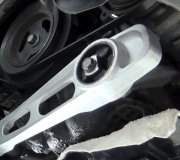What's important is if the suspension parts are in the right places. If a part of the frame that's bent is ahead of the lower control arms and upper strut mounts, there is nothing to worry about. Even when the suspension is tweaked a little, what's important is if a four-wheel alignment will take care of it. You always want the alignment checked after any hard impact and after any frame damage is repaired. There are three main alignment angles that are checked and / or adjusted on every alignment. Those are camber, caster, and toe. I can interpret those numbers from the printout.
Then there's some other angles to look at closer after crash damage has been repaired. One in particular is "steering axis inclination, (SAI). All alignment computers measure that automatically, but few of us look at it unless we know it may have changed, or when we're looking deeper into the cause of a handling problem. There is no spec. Given for SAI. All that is critical is it is the same on both sides. A typical reading is 28 degrees. If that is not the same on both sides, the car will dart in various directions as the tires hit small bumps in the road. There will be no way to predict which way it will go, and it will never do the same thing twice.
On some cars, such as GM products, the engine cradle has to be removed to remove the engine or transmission, and it can be reinstalled in a different orientation unless the mechanic knows to mark it first. Miserable handling is a common problem on these cars until SAI is corrected on the alignment rack. On most other cars the cross member is welded to the body so the only way SAI can become unequal is from crash damage. If all that's bent is up front by the radiator, the alignment should show that SAI is still equal. That will prove you have nothing to worry about.
Another thing to look at on the alignment printout is "thrust angle". That is simply the way the rear wheels are steering. It is very rare to find a car with the thrust angle at a perfect 0.00 degrees, but it shouldn't be excessively off to one side. All vehicles today get a four-wheel alignment, and as the final step in the sequence of adjustments, toe on each front wheel is set to match the rear wheels. The alignment computer calculates that automatically. This results in all four wheels pointing the same direction for good handling and tire wear, AND it insures a straight steering wheel. When thrust angle is not a perfect 0.00 degrees, in effect it is like having all four wheel perfectly parallel, then picking up the body off the frame and setting it back down after turning it a little. The alignment hasn't changed, so there won't be any abnormal tire wear and no handling problems.
Thursday, January 29th, 2015 AT 2:08 PM

